(All information courtesy of the instrument teams.)
![]() Previous IAU Circulars
Previous IAU Circulars
TITLE: GCN/SWIFT NOTICE
NOTICE_DATE: Sat 05 Feb 11 02:03:57 UT
NOTICE_TYPE: Swift-BAT GRB Position
TRIGGER_NUM: 444643, Seg_Num: 0
GRB_RA: 164.589d {+10h 58m 21s} (J2000),
164.770d {+10h 59m 05s} (current),
163.763d {+10h 55m 03s} (1950)
GRB_DEC: +67.516d {+67d 30' 58"} (J2000),
+67.456d {+67d 27' 23"} (current),
+67.784d {+67d 47' 02"} (1950)
GRB_ERROR: 3.00 [arcmin radius, statistical only]
GRB_INTEN: 0 [cnts] Image_Peak=1476 [image_cnts]
TRIGGER_DUR: 64.000 [sec]
TRIGGER_INDEX: 20000 E_range: 15-50 keV
BKG_INTEN: 0 [cnts]
BKG_TIME: 0.00 SOD {00:00:00.00} UT
BKG_DUR: 0 [sec]
GRB_DATE: 15597 TJD; 36 DOY; 11/02/05
GRB_TIME: 7361.36 SOD {02:02:41.36} UT
GRB_PHI: 159.99 [deg]
GRB_THETA: 43.20 [deg]
SOLN_STATUS: 0x13
RATE_SIGNIF: 0.00 [sigma]
IMAGE_SIGNIF: 10.04 [sigma]
MERIT_PARAMS: +1 +0 +0 +6 +1 +0 +0 +0 +58 +0
SUN_POSTN: 318.37d {+21h 13m 28s} -16.07d {-16d 04' 00"}
SUN_DIST: 125.85 [deg] Sun_angle= 10.2 [hr] (West of Sun)
MOON_POSTN: 337.70d {+22h 30m 49s} -4.28d {-04d 16' 47"}
MOON_DIST: 116.64 [deg]
MOON_ILLUM: 4 [%]
GAL_COORDS: 138.09, 46.14 [deg] galactic lon,lat of the burst (or transient)
ECL_COORDS: 128.66, 53.83 [deg] ecliptic lon,lat of the burst (or transient)
COMMENTS: SWIFT-BAT GRB Coordinates.
COMMENTS: This is an image trigger. (The RATE_SIGNIF & BKG_{INTEN, TIME, DUR} are undefined.)
COMMENTS: A point_source was found.
COMMENTS: This does not match any source in the on-board catalog.
COMMENTS: This does not match any source in the ground catalog.
COMMENTS: This is a GRB.
COMMENTS: This trigger occurred at longitude,latitude = 317.42,19.58 [deg].
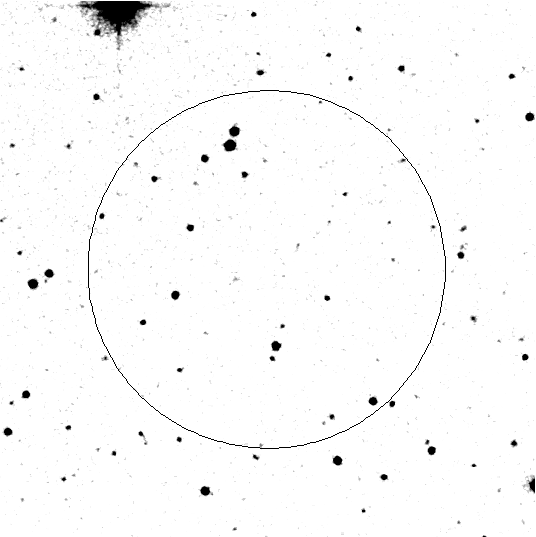
TITLE: GCN/SWIFT NOTICE
NOTICE_DATE: Sat 05 Feb 11 02:05:51 UT
NOTICE_TYPE: Swift-XRT Position
TRIGGER_NUM: 444643, Seg_Num: 0
GRB_RA: 164.6321d {+10h 58m 31.70s} (J2000),
164.8135d {+10h 59m 15.25s} (current),
163.8074d {+10h 55m 13.77s} (1950)
GRB_DEC: +67.5230d {+67d 31' 22.7"} (J2000),
+67.4634d {+67d 27' 48.2"} (current),
+67.7909d {+67d 47' 27.2"} (1950)
GRB_ERROR: 6.2 [arcsec radius, statistical plus systematic, 90% containment]
GRB_INTEN: 1.40e-08 [erg/cm2/sec]
GRB_SIGNIF: 5.09 [sigma]
IMG_START_DATE: 15597 TJD; 36 DOY; 11/02/05
IMG_START_TIME: 7516.76 SOD {02:05:16.76} UT, 155.4 [sec] since BAT Trigger Time
TAM[0-3]: 327.62 237.25 261.45 243.56
AMPLIFIER: 2
WAVEFORM: 134
SUN_POSTN: 318.37d {+21h 13m 29s} -16.07d {-16d 03' 59"}
SUN_DIST: 125.83 [deg] Sun_angle= 10.2 [hr] (West of Sun)
MOON_POSTN: 337.72d {+22h 30m 53s} -4.27d {-04d 16' 24"}
MOON_DIST: 116.62 [deg]
MOON_ILLUM: 4 [%]
GAL_COORDS: 138.06, 46.15 [deg] galactic lon,lat of the burst
ECL_COORDS: 128.68, 53.85 [deg] ecliptic lon,lat of the burst
COMMENTS: SWIFT-XRT Coordinates.
COMMENTS: The XRT position is 1.08 arcmin from the BAT position.
TITLE: GCN/SWIFT NOTICE
NOTICE_DATE: Sat 05 Feb 11 02:05:54 UT
NOTICE_TYPE: Swift-XRT Image
TRIGGER_NUM: 444643, Seg_Num: 0
GRB_RA: 164.6321d {+10h 58m 31.7s} (J2000),
164.8135d {+10h 59m 15.2s} (current),
163.8074d {+10h 55m 13.7s} (1950)
GRB_DEC: +67.5230d {+67d 31' 22.7"} (J2000),
+67.4634d {+67d 27' 48.2"} (current),
+67.7909d {+67d 47' 27.2"} (1950)
GRB_ERROR: 6.1 [arcsec, radius, statistical plus systematic]
GRB_INTEN: 26 [cnts]
IMG_START_DATE: 15597 TJD; 36 DOY; 11/02/05
IMG_START_TIME: 7516.76 SOD {02:05:16.76} UT, 155.4 [sec] since BAT Trigger Time
CENTROID_X: 293.77, raw= 294 [pixels]
CENTROID_Y: 297.54, raw= 298 [pixels]
ROLL: 31.61 [deg]
GAIN: 1
MODE: 2, Short Image mode
WAVEFORM: 134
EXPO_TIME: 0.10 [sec]
GRB_POS_XRT_Y: -1.07
GRB_POS_XRT_Z: -20.09
IMAGE_URL: sw00444643000msxps_rw.img
SUN_POSTN: 318.37d {+21h 13m 29s} -16.07d {-16d 03' 59"}
SUN_DIST: 125.83 [deg] Sun_angle= 10.2 [hr] (West of Sun)
MOON_POSTN: 337.72d {+22h 30m 53s} -4.27d {-04d 16' 23"}
MOON_DIST: 116.62 [deg]
MOON_ILLUM: 4 [%]
GAL_COORDS: 138.06, 46.15 [deg] galactic lon,lat of the burst
ECL_COORDS: 128.68, 53.85 [deg] ecliptic lon,lat of the burst
COMMENTS: SWIFT-XRT Image.

TITLE: GCN/SWIFT NOTICE
NOTICE_DATE: Sat 05 Feb 11 02:05:59 UT
NOTICE_TYPE: Swift-XRT Processed Image
TRIGGER_NUM: 444643, Seg_Num: 0
GRB_RA: 164.6321d {+10h 58m 31.7s} (J2000),
164.8135d {+10h 59m 15.2s} (current),
163.8074d {+10h 55m 13.7s} (1950)
GRB_DEC: +67.5230d {+67d 31' 22.7"} (J2000),
+67.4634d {+67d 27' 48.2"} (current),
+67.7909d {+67d 47' 27.2"} (1950)
GRB_ERROR: 6.1 [arcsec, radius, statistical plus systematic]
GRB_INTEN: 26 [cnts]
IMG_START_DATE: 15597 TJD; 36 DOY; 11/02/05
IMG_START_TIME: 7516.76 SOD {02:05:16.76} UT, 155.4 [sec] since BAT Trigger Time
CENTROID_X: 293.77, raw= 294 [pixels]
CENTROID_Y: 297.54, raw= 298 [pixels]
ROLL: 31.61 [deg]
GAIN: 1
MODE: 2, Short Image mode
WAVEFORM: 134
EXPO_TIME: 0.10 [sec]
GRB_POS_XRT_Y: -1.07
GRB_POS_XRT_Z: -20.09
IMAGE_URL: sw00444643000msxps_rw.img
SUN_POSTN: 318.37d {+21h 13m 29s} -16.07d {-16d 03' 59"}
SUN_DIST: 125.83 [deg] Sun_angle= 10.2 [hr] (West of Sun)
MOON_POSTN: 337.72d {+22h 30m 53s} -4.27d {-04d 16' 22"}
MOON_DIST: 116.62 [deg]
MOON_ILLUM: 4 [%]
GAL_COORDS: 138.06, 46.15 [deg] galactic lon,lat of the burst
ECL_COORDS: 128.68, 53.85 [deg] ecliptic lon,lat of the burst
COMMENTS: SWIFT-XRT Processed Image.

TITLE: GCN/SWIFT NOTICE
NOTICE_DATE: Sat 05 Feb 11 02:06:44 UT
NOTICE_TYPE: Swift-BAT GRB Lightcurve
TRIGGER_NUM: 444643, Seg_Num: 0
GRB_RA: 164.589d {+10h 58m 21s} (J2000),
164.770d {+10h 59m 05s} (current),
163.763d {+10h 55m 03s} (1950)
GRB_DEC: +67.516d {+67d 30' 58"} (J2000),
+67.456d {+67d 27' 23"} (current),
+67.784d {+67d 47' 02"} (1950)
GRB_DATE: 15597 TJD; 36 DOY; 11/02/05
GRB_TIME: 7361.36 SOD {02:02:41.36} UT
TRIGGER_INDEX: 20000
GRB_PHI: 159.99 [deg]
GRB_THETA: 43.20 [deg]
DELTA_TIME: 0.00 [sec]
TRIGGER_DUR: 64.000 [sec]
SOLN_STATUS: 0x13
RATE_SIGNIF: 0.00 [sigma]
IMAGE_SIGNIF: 10.04 [sigma]
LC_URL: sw00444643000msb.lc
SUN_POSTN: 318.37d {+21h 13m 29s} -16.07d {-16d 03' 58"}
SUN_DIST: 125.84 [deg] Sun_angle= 10.2 [hr] (West of Sun)
MOON_POSTN: 337.73d {+22h 30m 54s} -4.27d {-04d 16' 13"}
MOON_DIST: 116.63 [deg]
MOON_ILLUM: 4 [%]
GAL_COORDS: 138.09, 46.14 [deg] galactic lon,lat of the burst (or transient)
ECL_COORDS: 128.66, 53.83 [deg] ecliptic lon,lat of the burst (or transient)
COMMENTS: SWIFT-BAT GRB Lightcurve.
COMMENTS:
COMMENTS: The next comments were copied from the BAT_POS Notice:
COMMENTS: This is an image trigger.
COMMENTS: A point_source was found.
COMMENTS: This does not match any source in the on-board catalog.
COMMENTS: This does not match any source in the ground catalog.
COMMENTS: This is a GRB.
COMMENTS: This trigger occurred at longitude,latitude = 317.42,19.58 [deg].
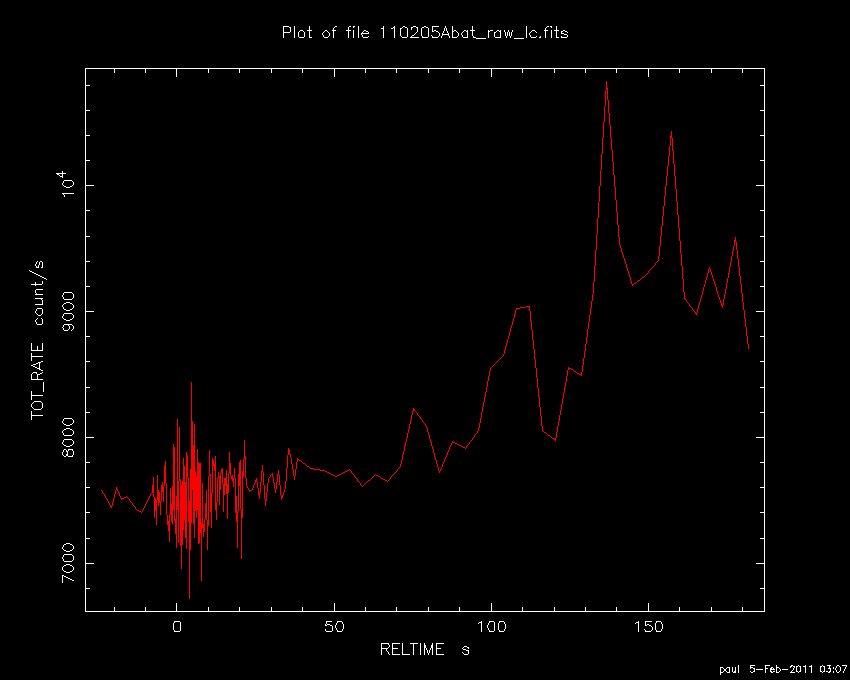
TITLE: GCN/SWIFT NOTICE
NOTICE_DATE: Sat 05 Feb 11 02:08:14 UT
NOTICE_TYPE: Swift-UVOT Source List
TRIGGER_NUM: 444643, Seg_Num: 0
POINT_RA: 164.619d {+10h 58m 29s} (J2000)
POINT_DEC: +67.520d {+67d 31' 12"} (J2000)
POINT_ROLL: 31.602d
IMG_START_DATE: 15597 TJD; 36 DOY; 11/02/05
IMG_START_TIME: 7525.38 SOD {02:05:25.38} UT, 164.0 [sec] since BAT Trigger Time
FILTER: 10, White
BKG_MEAN: 1.517
N_STARS: 47
X_OFFSET: 384 [pixels]
Y_OFFSET: 528 [pixels]
X_MAX: 1343 [pixels]
Y_MAX: 1487 [pixels]
DET_THRESH: 10
PHOTO_THRESH: 5
SL_URL: sw00444643000msufc0164.fits
SUN_POSTN: 318.37d {+21h 13m 29s} -16.07d {-16d 03' 57"}
SUN_DIST: 125.84 [deg] Sun_angle= 10.2 [hr] (West of Sun)
MOON_POSTN: 337.74d {+22h 30m 57s} -4.27d {-04d 15' 55"}
MOON_DIST: 116.62 [deg]
MOON_ILLUM: 4 [%]
GAL_COORDS: 138.07, 46.15 [deg] galactic lon,lat of the pointing direction
ECL_COORDS: 128.67, 53.85 [deg] ecliptic lon,lat of the pointing direction
COMMENTS: SWIFT-UVOT Source List.
TITLE: GCN/SWIFT NOTICE
NOTICE_DATE: Sat 05 Feb 11 02:08:41 UT
NOTICE_TYPE: Swift-UVOT Processed Source List
TRIGGER_NUM: 444643, Seg_Num: 0
POINT_RA: 164.619d {+10h 58m 29s} (J2000)
POINT_DEC: +67.520d {+67d 31' 12"} (J2000)
POINT_ROLL: 31.602d
IMG_START_DATE: 15597 TJD; 36 DOY; 11/02/05
IMG_START_TIME: 7525.38 SOD {02:05:25.38} UT, 164.0 [sec] since BAT Trigger Time
FILTER: 10, White
BKG_MEAN: 1.517
N_STARS: 47
X_OFFSET: 384 [pixels]
Y_OFFSET: 528 [pixels]
X_MAX: 1343 [pixels]
Y_MAX: 1487 [pixels]
DET_THRESH: 10
PHOTO_THRESH: 5
SL_URL: sw00444643000msufc0164.fits
SUN_POSTN: 318.37d {+21h 13m 29s} -16.07d {-16d 03' 57"}
SUN_DIST: 125.84 [deg] Sun_angle= 10.2 [hr] (West of Sun)
MOON_POSTN: 337.74d {+22h 30m 58s} -4.26d {-04d 15' 50"}
MOON_DIST: 116.62 [deg]
MOON_ILLUM: 4 [%]
GAL_COORDS: 138.07, 46.15 [deg] galactic lon,lat of the pointing direction
ECL_COORDS: 128.67, 53.85 [deg] ecliptic lon,lat of the pointing direction
COMMENTS: SWIFT-UVOT Processed Source List.
COMMENTS: All 4 attachments are included.
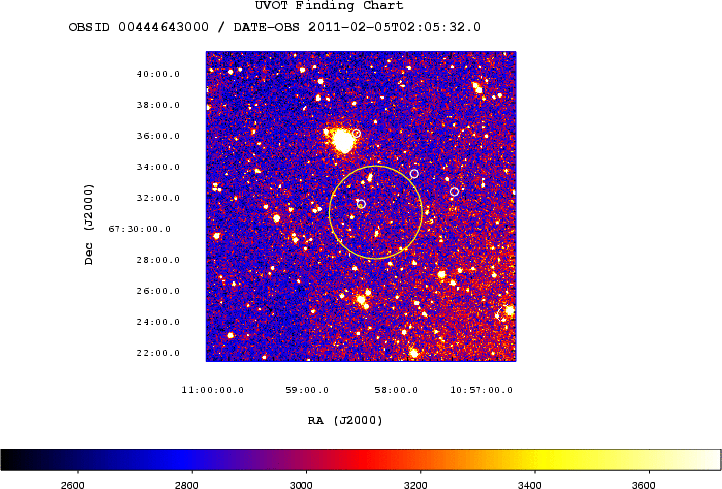
TITLE: GCN/SWIFT NOTICE
NOTICE_DATE: Sat 05 Feb 11 02:09:31 UT
NOTICE_TYPE: Swift-UVOT Image
TRIGGER_NUM: 444643, Seg_Num: 0
POINT_RA: 164.619d {+10h 58m 29s} (J2000)
POINT_DEC: +67.520d {+67d 31' 12"} (J2000)
ROLL: 31.602d
IMG_START_DATE: 15597 TJD; 36 DOY; 11/02/05
IMG_START_TIME: 7525.38 SOD {02:05:25.38} UT, 164.0 [sec] since BAT Trigger Time
FILTER: 10, White
EXPOSURE_ID: 318564332
X_OFFSET: 832 [pixels]
Y_OFFSET: 857 [pixels]
WIDTH: 160 [pixels]
HEIGHT: 160 [pixels]
X_GRB_POS: 992
Y_GRB_POS: 1017
BINNING_INDEX: 1
IM_URL: sw00444643000msuni0171.fits
SUN_POSTN: 318.37d {+21h 13m 29s} -16.07d {-16d 03' 56"}
SUN_DIST: 125.84 [deg] Sun_angle= 10.2 [hr] (West of Sun)
MOON_POSTN: 337.75d {+22h 30m 59s} -4.26d {-04d 15' 40"}
MOON_DIST: 116.62 [deg]
MOON_ILLUM: 4 [%]
GAL_COORDS: 138.07, 46.15 [deg] galactic lon,lat of the pointing direction
ECL_COORDS: 128.67, 53.85 [deg] ecliptic lon,lat of the pointing direction
COMMENTS: SWIFT-UVOT Image.
COMMENTS: The GRB Position came from the XRT Position Command.
COMMENTS: The image has 2x2 binning (compression).
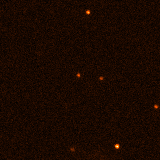
TITLE: GCN/SWIFT NOTICE
NOTICE_DATE: Sat 05 Feb 11 02:09:48 UT
NOTICE_TYPE: Swift-UVOT Processed Image
TRIGGER_NUM: 444643, Seg_Num: 0
POINT_RA: 164.619d {+10h 58m 29s} (J2000)
POINT_DEC: +67.520d {+67d 31' 12"} (J2000)
ROLL: 31.602d
IMG_START_DATE: 15597 TJD; 36 DOY; 11/02/05
IMG_START_TIME: 7525.38 SOD {02:05:25.38} UT, 164.0 [sec] since BAT Trigger Time
FILTER: 10, White
EXPOSURE_ID: 318564332
X_OFFSET: 832 [pixels]
Y_OFFSET: 857 [pixels]
WIDTH: 160 [pixels]
HEIGHT: 160 [pixels]
X_GRB_POS: 992
Y_GRB_POS: 1017
BINNING_INDEX: 1
IM_URL: sw00444643000msuni0171.fits
SUN_POSTN: 318.37d {+21h 13m 29s} -16.07d {-16d 03' 56"}
SUN_DIST: 125.84 [deg] Sun_angle= 10.2 [hr] (West of Sun)
MOON_POSTN: 337.75d {+22h 31m 00s} -4.26d {-04d 15' 37"}
MOON_DIST: 116.61 [deg]
MOON_ILLUM: 4 [%]
GAL_COORDS: 138.07, 46.15 [deg] galactic lon,lat of the pointing direction
ECL_COORDS: 128.67, 53.85 [deg] ecliptic lon,lat of the pointing direction
COMMENTS: SWIFT-UVOT Processed Image.
COMMENTS: The GRB Position came from the XRT Position Command.
COMMENTS: The image has 2x2 binning (compression).
COMMENTS: All 4 attachments are included.
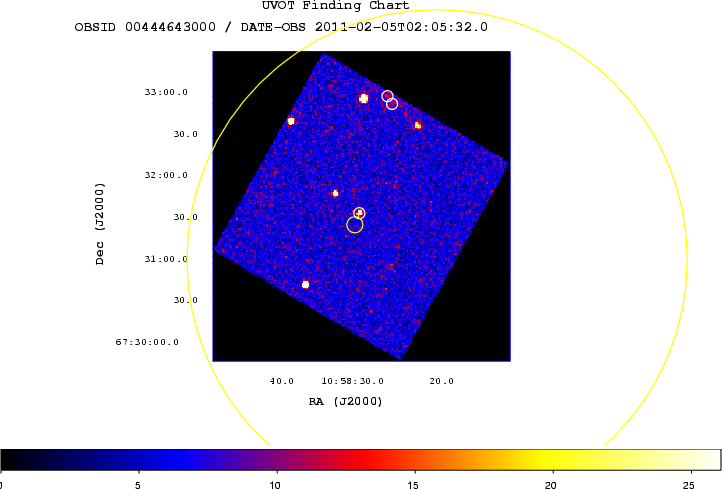
TITLE: GCN/SWIFT NOTICE
NOTICE_DATE: Sat 05 Feb 11 02:12:35 UT
NOTICE_TYPE: Swift-UVOT Source List
TRIGGER_NUM: 444643, Seg_Num: 0
POINT_RA: 164.624d {+10h 58m 30s} (J2000)
POINT_DEC: +67.519d {+67d 31' 07"} (J2000)
POINT_ROLL: 31.610d
IMG_START_DATE: 15597 TJD; 36 DOY; 11/02/05
IMG_START_TIME: 7683.29 SOD {02:08:03.29} UT, 321.9 [sec] since BAT Trigger Time
FILTER: 7, U
BKG_MEAN: 0.475
N_STARS: 112
X_OFFSET: 512 [pixels]
Y_OFFSET: 537 [pixels]
X_MAX: 1471 [pixels]
Y_MAX: 1496 [pixels]
DET_THRESH: 6
PHOTO_THRESH: 3
SL_URL: sw00444643000msufc0321.fits
SUN_POSTN: 318.37d {+21h 13m 30s} -16.07d {-16d 03' 54"}
SUN_DIST: 125.84 [deg] Sun_angle= 10.2 [hr] (West of Sun)
MOON_POSTN: 337.77d {+22h 31m 05s} -4.25d {-04d 15' 03"}
MOON_DIST: 116.61 [deg]
MOON_ILLUM: 4 [%]
GAL_COORDS: 138.07, 46.15 [deg] galactic lon,lat of the pointing direction
ECL_COORDS: 128.68, 53.85 [deg] ecliptic lon,lat of the pointing direction
COMMENTS: SWIFT-UVOT Source List.
TITLE: GCN/SWIFT NOTICE
NOTICE_DATE: Sat 05 Feb 11 02:12:55 UT
NOTICE_TYPE: Swift-UVOT Processed Source List
TRIGGER_NUM: 444643, Seg_Num: 0
POINT_RA: 164.624d {+10h 58m 30s} (J2000)
POINT_DEC: +67.519d {+67d 31' 07"} (J2000)
POINT_ROLL: 31.610d
IMG_START_DATE: 15597 TJD; 36 DOY; 11/02/05
IMG_START_TIME: 7683.29 SOD {02:08:03.29} UT, 321.9 [sec] since BAT Trigger Time
FILTER: 7, U
BKG_MEAN: 0.475
N_STARS: 112
X_OFFSET: 512 [pixels]
Y_OFFSET: 537 [pixels]
X_MAX: 1471 [pixels]
Y_MAX: 1496 [pixels]
DET_THRESH: 6
PHOTO_THRESH: 3
SL_URL: sw00444643000msufc0321.fits
SUN_POSTN: 318.37d {+21h 13m 30s} -16.07d {-16d 03' 54"}
SUN_DIST: 125.84 [deg] Sun_angle= 10.2 [hr] (West of Sun)
MOON_POSTN: 337.77d {+22h 31m 06s} -4.25d {-04d 15' 00"}
MOON_DIST: 116.61 [deg]
MOON_ILLUM: 4 [%]
GAL_COORDS: 138.07, 46.15 [deg] galactic lon,lat of the pointing direction
ECL_COORDS: 128.68, 53.85 [deg] ecliptic lon,lat of the pointing direction
COMMENTS: SWIFT-UVOT Processed Source List.
COMMENTS: All 4 attachments are included.
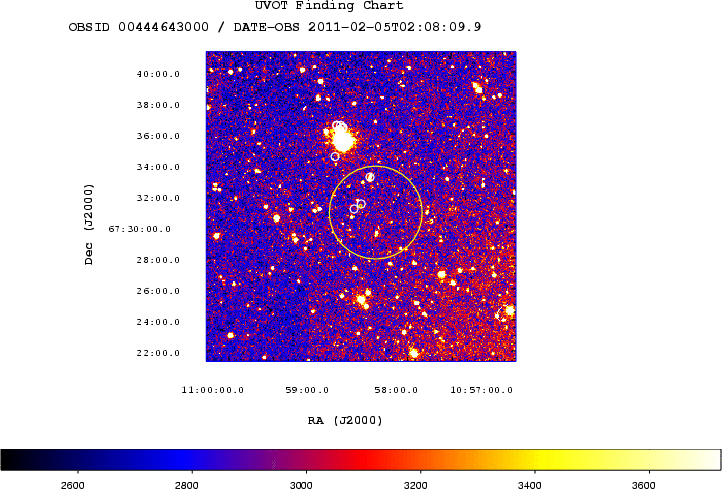
TITLE: GCN/SWIFT NOTICE
NOTICE_DATE: Sat 05 Feb 11 02:13:40 UT
NOTICE_TYPE: Swift-UVOT Image
TRIGGER_NUM: 444643, Seg_Num: 0
POINT_RA: 164.624d {+10h 58m 30s} (J2000)
POINT_DEC: +67.519d {+67d 31' 07"} (J2000)
ROLL: 31.610d
IMG_START_DATE: 15597 TJD; 36 DOY; 11/02/05
IMG_START_TIME: 7683.29 SOD {02:08:03.29} UT, 321.9 [sec] since BAT Trigger Time
FILTER: 7, U
EXPOSURE_ID: 318564489
X_OFFSET: 832 [pixels]
Y_OFFSET: 857 [pixels]
WIDTH: 160 [pixels]
HEIGHT: 160 [pixels]
X_GRB_POS: 992
Y_GRB_POS: 1017
BINNING_INDEX: 1
IM_URL: sw00444643000msuni0328.fits
SUN_POSTN: 318.37d {+21h 13m 30s} -16.06d {-16d 03' 53"}
SUN_DIST: 125.84 [deg] Sun_angle= 10.2 [hr] (West of Sun)
MOON_POSTN: 337.78d {+22h 31m 07s} -4.25d {-04d 14' 50"}
MOON_DIST: 116.60 [deg]
MOON_ILLUM: 4 [%]
GAL_COORDS: 138.07, 46.15 [deg] galactic lon,lat of the pointing direction
ECL_COORDS: 128.68, 53.85 [deg] ecliptic lon,lat of the pointing direction
COMMENTS: SWIFT-UVOT Image.
COMMENTS: The GRB Position came from the XRT Position Command.
COMMENTS: The image has 2x2 binning (compression).
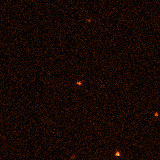
TITLE: GCN/SWIFT NOTICE
NOTICE_DATE: Sat 05 Feb 11 02:13:54 UT
NOTICE_TYPE: Swift-UVOT Processed Image
TRIGGER_NUM: 444643, Seg_Num: 0
POINT_RA: 164.624d {+10h 58m 30s} (J2000)
POINT_DEC: +67.519d {+67d 31' 07"} (J2000)
ROLL: 31.610d
IMG_START_DATE: 15597 TJD; 36 DOY; 11/02/05
IMG_START_TIME: 7683.29 SOD {02:08:03.29} UT, 321.9 [sec] since BAT Trigger Time
FILTER: 7, U
EXPOSURE_ID: 318564489
X_OFFSET: 832 [pixels]
Y_OFFSET: 857 [pixels]
WIDTH: 160 [pixels]
HEIGHT: 160 [pixels]
X_GRB_POS: 992
Y_GRB_POS: 1017
BINNING_INDEX: 1
IM_URL: sw00444643000msuni0328.fits
SUN_POSTN: 318.37d {+21h 13m 30s} -16.06d {-16d 03' 53"}
SUN_DIST: 125.84 [deg] Sun_angle= 10.2 [hr] (West of Sun)
MOON_POSTN: 337.78d {+22h 31m 07s} -4.25d {-04d 14' 47"}
MOON_DIST: 116.60 [deg]
MOON_ILLUM: 4 [%]
GAL_COORDS: 138.07, 46.15 [deg] galactic lon,lat of the pointing direction
ECL_COORDS: 128.68, 53.85 [deg] ecliptic lon,lat of the pointing direction
COMMENTS: SWIFT-UVOT Processed Image.
COMMENTS: The GRB Position came from the XRT Position Command.
COMMENTS: The image has 2x2 binning (compression).
COMMENTS: All 4 attachments are included.
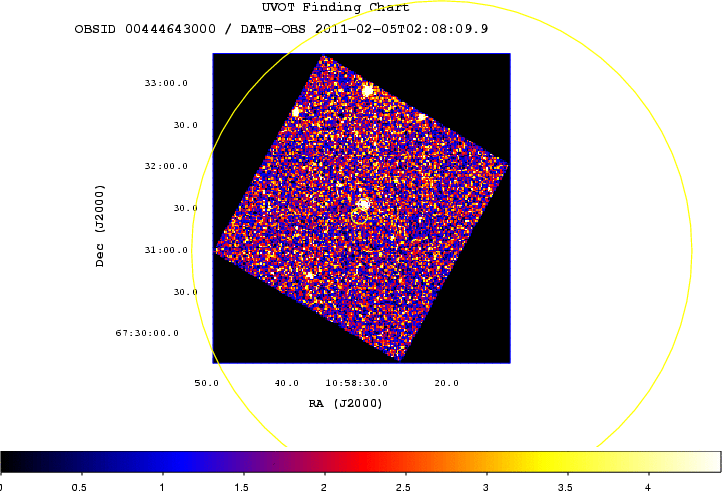
TITLE: GCN/SWIFT NOTICE
NOTICE_DATE: Sat 05 Feb 11 02:17:15 UT
NOTICE_TYPE: Swift-UVOT Position
TRIGGER_NUM: 444643, Seg_Num: 0
GRB_RA: 164.6296d {+10h 58m 31.10s} (J2000),
164.8111d {+10h 59m 14.65s} (current),
163.8049d {+10h 55m 13.16s} (1950)
GRB_DEC: +67.5253d {+67d 31' 31.0"} (J2000),
+67.4657d {+67d 27' 56.5"} (current),
+67.7932d {+67d 47' 35.5"} (1950)
GRB_ERROR: 0.6 [arcsec radius, statistical only]
GRB_MAG: 18.70 +/- 0.14 [mag]
FILTER: 10, White
IMG_START_DATE: 15597 TJD; 36 DOY; 11/02/05
IMG_START_TIME: 7530.00 SOD {02:05:30.00} UT, 168.6 [sec] since BAT Trigger Time
SUN_POSTN: 318.38d {+21h 13m 30s} -16.06d {-16d 03' 50"}
SUN_DIST: 125.83 [deg] Sun_angle= 10.2 [hr] (West of Sun)
MOON_POSTN: 337.81d {+22h 31m 13s} -4.24d {-04d 14' 07"}
MOON_DIST: 116.59 [deg]
MOON_ILLUM: 4 [%]
GAL_COORDS: 138.06, 46.15 [deg] galactic lon,lat of the burst (or transient)
ECL_COORDS: 128.67, 53.85 [deg] ecliptic lon,lat of the burst (or transient)
COMMENTS: SWIFT UVOT Position Notice.
COMMENTS: This Notice was ground-generated -- not flight-generated.
COMMENTS: The UVOT position is 8.6 arcsec from the XRT position.
RA(J2000) = 10h 58m 21s Dec(J2000) = +67d 30' 58"with an uncertainty of 3 arcmin (radius, 90% containment, including systematic uncertainty). The BAT lightcurve shows activity with multiple peaks until at least T+300 seconds, with a peak count rate of 4500 counts/s (15-150 keV) at T+210 s.
RA(J2000) = 10h 58m 31.70s Dec(J2000) = +67d 31' 22.7"with an uncertainty of 6.2 arcseconds (radius, 90% containment). This location is 64 arcseconds from the BAT onboard position, within the BAT error circle. No event data are yet available to determine the column density using X-ray spectroscopy.
RA(J2000) = 10:58:31.12 = 164.62965 DEC(J2000) = +67:31:31.2 = 67.52532with a 90%-confidence error radius of about 0.63 arc sec. This position is 9.0 arc sec. from the center of the XRT error circle. The estimated magnitude is 18.71 with a 1-sigma error of about 0.15. No correction has been made for the expected extinction corresponding to E(B-V) of 0.01.
TITLE: GCN/SWIFT NOTICE
NOTICE_DATE: Sat 05 Feb 11 02:20:09 UT
NOTICE_TYPE: Swift-UVOT Source List
TRIGGER_NUM: 444643, Seg_Num: 0
POINT_RA: 164.624d {+10h 58m 30s} (J2000)
POINT_DEC: +67.518d {+67d 31' 06"} (J2000)
POINT_ROLL: 31.610d
IMG_START_DATE: 15597 TJD; 36 DOY; 11/02/05
IMG_START_TIME: 8236.78 SOD {02:17:16.78} UT, 875.4 [sec] since BAT Trigger Time
FILTER: 10, White
BKG_MEAN: 1.647
N_STARS: 166
X_OFFSET: 272 [pixels]
Y_OFFSET: 297 [pixels]
X_MAX: 1711 [pixels]
Y_MAX: 1736 [pixels]
DET_THRESH: 11
PHOTO_THRESH: 5
SL_URL: sw00444643000msufc0875.fits
SUN_POSTN: 318.38d {+21h 13m 31s} -16.06d {-16d 03' 48"}
SUN_DIST: 125.83 [deg] Sun_angle= 10.2 [hr] (West of Sun)
MOON_POSTN: 337.83d {+22h 31m 19s} -4.23d {-04d 13' 32"}
MOON_DIST: 116.59 [deg]
MOON_ILLUM: 4 [%]
GAL_COORDS: 138.07, 46.15 [deg] galactic lon,lat of the pointing direction
ECL_COORDS: 128.68, 53.85 [deg] ecliptic lon,lat of the pointing direction
COMMENTS: SWIFT-UVOT Source List.
TITLE: GCN/SWIFT NOTICE
NOTICE_DATE: Sat 05 Feb 11 02:20:28 UT
NOTICE_TYPE: Swift-UVOT Processed Source List
TRIGGER_NUM: 444643, Seg_Num: 0
POINT_RA: 164.624d {+10h 58m 30s} (J2000)
POINT_DEC: +67.518d {+67d 31' 06"} (J2000)
POINT_ROLL: 31.610d
IMG_START_DATE: 15597 TJD; 36 DOY; 11/02/05
IMG_START_TIME: 8236.78 SOD {02:17:16.78} UT, 875.4 [sec] since BAT Trigger Time
FILTER: 10, White
BKG_MEAN: 1.647
N_STARS: 166
X_OFFSET: 272 [pixels]
Y_OFFSET: 297 [pixels]
X_MAX: 1711 [pixels]
Y_MAX: 1736 [pixels]
DET_THRESH: 11
PHOTO_THRESH: 5
SL_URL: sw00444643000msufc0875.fits
SUN_POSTN: 318.38d {+21h 13m 31s} -16.06d {-16d 03' 48"}
SUN_DIST: 125.83 [deg] Sun_angle= 10.2 [hr] (West of Sun)
MOON_POSTN: 337.83d {+22h 31m 19s} -4.22d {-04d 13' 28"}
MOON_DIST: 116.58 [deg]
MOON_ILLUM: 4 [%]
GAL_COORDS: 138.07, 46.15 [deg] galactic lon,lat of the pointing direction
ECL_COORDS: 128.68, 53.85 [deg] ecliptic lon,lat of the pointing direction
COMMENTS: SWIFT-UVOT Processed Source List.
COMMENTS: All 4 attachments are included.
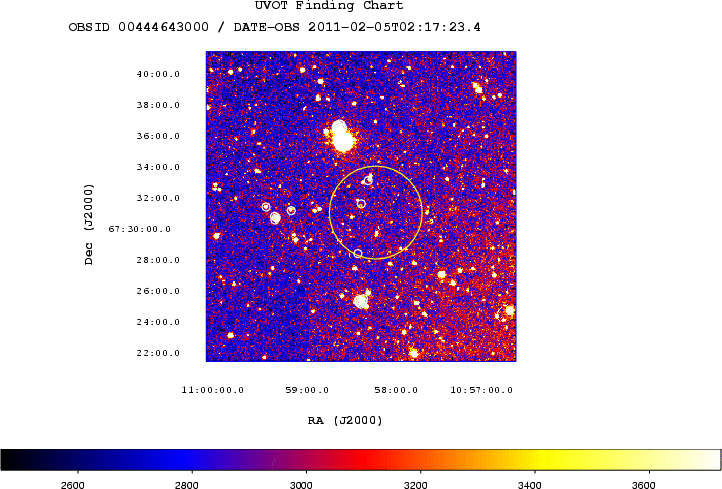
TITLE: GCN/SWIFT NOTICE
NOTICE_DATE: Sat 05 Feb 11 02:21:47 UT
NOTICE_TYPE: Swift-UVOT Image
TRIGGER_NUM: 444643, Seg_Num: 0
POINT_RA: 164.624d {+10h 58m 30s} (J2000)
POINT_DEC: +67.518d {+67d 31' 06"} (J2000)
ROLL: 31.610d
IMG_START_DATE: 15597 TJD; 36 DOY; 11/02/05
IMG_START_TIME: 8236.78 SOD {02:17:16.78} UT, 875.4 [sec] since BAT Trigger Time
FILTER: 10, White
EXPOSURE_ID: 318565043
X_OFFSET: 831 [pixels]
Y_OFFSET: 856 [pixels]
WIDTH: 160 [pixels]
HEIGHT: 160 [pixels]
X_GRB_POS: 991
Y_GRB_POS: 1016
BINNING_INDEX: 1
IM_URL: sw00444643000msuni0882.fits
SUN_POSTN: 318.38d {+21h 13m 31s} -16.06d {-16d 03' 47"}
SUN_DIST: 125.83 [deg] Sun_angle= 10.2 [hr] (West of Sun)
MOON_POSTN: 337.84d {+22h 31m 22s} -4.22d {-04d 13' 12"}
MOON_DIST: 116.58 [deg]
MOON_ILLUM: 4 [%]
GAL_COORDS: 138.07, 46.15 [deg] galactic lon,lat of the pointing direction
ECL_COORDS: 128.68, 53.85 [deg] ecliptic lon,lat of the pointing direction
COMMENTS: SWIFT-UVOT Image.
COMMENTS: The GRB Position came from the Window Position in the Mode Command.
COMMENTS: The image has 2x2 binning (compression).
COMMENTS: This notice was forced out after watchdog timer expiring -- most likely due to missing packet(s);
COMMENTS: as a consequence some of the fields may be incoorect (eg TRIGGER_NUM,RA,DEC).

RA(J2000.0) = 10h 58m 31.25s DEC(J2000.0) +67d 31' 31.4"OT optical brightness increased until R~16.7 about 225s after GRB. Then it decreases.
TITLE: GCN/SWIFT NOTICE
NOTICE_DATE: Sat 05 Feb 11 02:22:06 UT
NOTICE_TYPE: Swift-UVOT Processed Image
TRIGGER_NUM: 444643, Seg_Num: 0
POINT_RA: 164.624d {+10h 58m 30s} (J2000)
POINT_DEC: +67.518d {+67d 31' 06"} (J2000)
ROLL: 31.610d
IMG_START_DATE: 15597 TJD; 36 DOY; 11/02/05
IMG_START_TIME: 8236.78 SOD {02:17:16.78} UT, 875.4 [sec] since BAT Trigger Time
FILTER: 10, White
EXPOSURE_ID: 318565043
X_OFFSET: 831 [pixels]
Y_OFFSET: 856 [pixels]
WIDTH: 160 [pixels]
HEIGHT: 160 [pixels]
X_GRB_POS: 991
Y_GRB_POS: 1016
BINNING_INDEX: 1
IM_URL: sw00444643000msuni0882.fits
SUN_POSTN: 318.38d {+21h 13m 31s} -16.06d {-16d 03' 47"}
SUN_DIST: 125.83 [deg] Sun_angle= 10.2 [hr] (West of Sun)
MOON_POSTN: 337.84d {+22h 31m 22s} -4.22d {-04d 13' 09"}
MOON_DIST: 116.58 [deg]
MOON_ILLUM: 4 [%]
GAL_COORDS: 138.07, 46.15 [deg] galactic lon,lat of the pointing direction
ECL_COORDS: 128.68, 53.85 [deg] ecliptic lon,lat of the pointing direction
COMMENTS: SWIFT-UVOT Processed Image.
COMMENTS: The GRB Position came from the Window Position in the Mode Command.
COMMENTS: The image has 2x2 binning (compression).
COMMENTS: All 4 attachments are included.
COMMENTS: This notice was forced out after watchdog timer expiring -- most likely due to missing packet(s);
COMMENTS: as a consequence some of the fields may be incoorect (eg TRIGGER_NUM,RA,DEC).
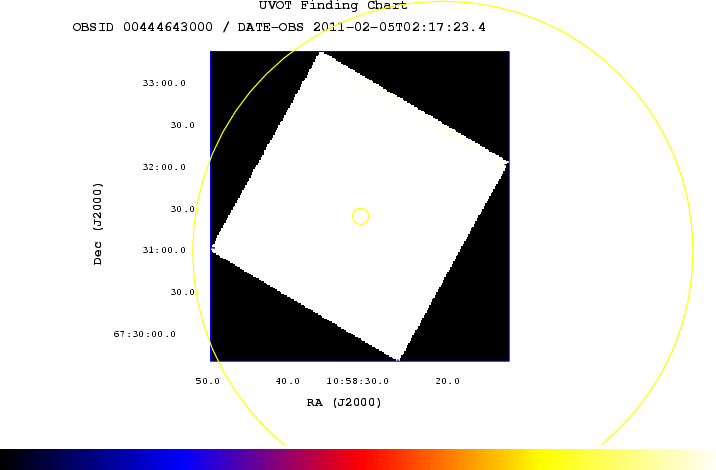
TITLE: GCN/SWIFT NOTICE
NOTICE_DATE: Sat 05 Feb 11 02:31:22 UT
NOTICE_TYPE: Swift-XRT Position UPDATE
TRIGGER_NUM: 444643, Seg_Num: 0
GRB_RA: 164.6280d {+10h 58m 30.71s} (J2000),
164.8095d {+10h 59m 14.26s} (current),
163.8032d {+10h 55m 12.77s} (1950)
GRB_DEC: +67.5252d {+67d 31' 30.7"} (J2000),
+67.4656d {+67d 27' 56.2"} (current),
+67.7931d {+67d 47' 35.1"} (1950)
GRB_ERROR: 3.8 [arcsec radius, statistical plus systematic, 90% containment]
GRB_INTEN: 1.00e-10 [erg/cm2/sec]
GRB_SIGNIF: 10.00 [sigma]
IMG_START_DATE: 15597 TJD; 36 DOY; 11/02/05
IMG_START_TIME: 8277.00 SOD {02:17:57.00} UT, 915.6 [sec] since BAT Trigger Time
TAM[0-3]: 100.00 100.00 100.00 100.00
AMPLIFIER: 1
WAVEFORM: 31
SUN_POSTN: 318.39d {+21h 13m 33s} -16.06d {-16d 03' 40"}
SUN_DIST: 125.83 [deg] Sun_angle= 10.2 [hr] (West of Sun)
MOON_POSTN: 337.91d {+22h 31m 39s} -4.19d {-04d 11' 17"}
MOON_DIST: 116.55 [deg]
MOON_ILLUM: 4 [%]
GAL_COORDS: 138.06, 46.15 [deg] galactic lon,lat of the burst
ECL_COORDS: 128.67, 53.85 [deg] ecliptic lon,lat of the burst
COMMENTS: SWIFT-XRT Coordinates.
COMMENTS: This Notice was ground-generated -- not flight-generated.
COMMENTS: This is an Update Notice -- the RA,Dec values herein supersede the previous XRT_POS Notice.
COMMENTS: TAM values, flux and significance fields are not valid.
COMMENTS: This position was automatically generated on the ground using
COMMENTS: Photon Counting data telemetered via TDRSS (SPER data).
COMMENTS: See http://www.swift.ac.uk/sper/docs.php for details.
COMMENTS: The probability that this is a serendipitous source in the
COMMENTS: SPER window is 0.58% < P(seren) < 1.1%.
start UT mag mlim(of image) ---------------------------------- 02:06:00.5 17.0 17.6This source is at the position of the Swift XRT and UVOT transients, and not visible in DSS (second epoch), 2MASS or the MPChecker database. On our first two sets of ten images, the source is faint, near our limit, while for our third and fourth coadded images the source has significnatly brightened by over two magnitudes, apparently to magnitude around 13.9.
Filter T_start(s) T_stop(s) Exp(s) Mag Mag_err white_FC 164 314 150 18.71 0.15 u_FC 321 571 250 18.17 0.15 white_FC 875 1025 150 15.4 0.4Observations are continuing.
post burst t_mid (hr) exp.(hr) filt mag m_err 3.59 0.50 J 16.74 0.05 3.59 0.50 H 15.81 0.05 3.59 0.50 Ks 15.19 0.07All magnitudes are given in the Vega system, calibrated to 2MASS. No correction for Galactic extinction has been made to the above reported values. Observations are continuing.
Tmid(s)+T0 Filter Exp (sec) Mag Mag err Limit 3537 unfilt 600 16.3 0.1 19.7 4249 Rc 600 16.5 0.1 18.9 5327 unfilt 300 16.8 0.1 19.7 5858 Rc 600 17.0 0.1 18.9 6379 Rc 300 17.3 0.1 18.9 6903 unfilt 600 17.3 0.1 19.7 7993 Rc 300 17.6 0.1 18.9 8367 unfilt 300 17.6 0.1 19.7A jpg image of the 600sec clear filter observation is available at the following URL link: http://cutenews.kassiopeia.net/data/upimages/GRB110205A.jpg
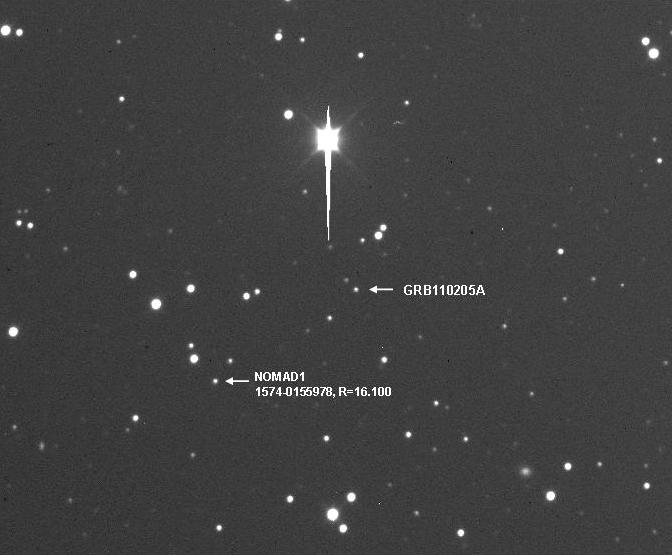
RA (J2000): 10h 58m 31.13s Dec (J2000): +67d 31' 30.8"with an uncertainty of 1.5 arcsec (radius, 90% confidence).
Galactic foreground: 1.6 x 10^20 cm^-2 Intrinsic column: 3.5 (+1.6, -1.5) x 10^21 cm^-2 at z=2.22 Photon index: 1.99 (+0.08, -0.07)The results of the XRT-team automatic analysis are available at http://www.swift.ac.uk/xrt_products/00444643.
RA(J2000) = 10h 58m 24.8s Dec(J2000) = +67d 31' 57.1"with an uncertainty of 2.2 arcmin, (radius, sys+stat, 90% containment). The partial coding was 29%.
USNO-SA 2.0 R Exp : hh:mm:ss 180s : 04:32:22 (UT) =3D 10h58m31.149s +67=C2=B031'30.89'' 17.44 +/-0.08 180s : 04:48:32 (UT) =3D 10h58m31.173s +67=C2=B031'30.88'' 17.84 +/-0.16 120s : 05:38:46 (UT) =3D 10h58m31.173s +67=C2=B031'30.86'' 18.09 +/-0.35 120s : 05:51:26 (UT) =3D 10h58m31.169s +67=C2=B031'30.71'' 17.99 +/-0.64Image & measurement : http://astrosurf.com/obsdauban/pages/GRB110205A.html
FILTER TSTART TSTOP MAG +/- UL(2o) white_FC 164.0 313.8 18.79 0.07 white 601.9 621.7 17.01 0.08 white 774.6 794.4 15.74 0.06 white_FC 875.4 1025.1 15.36 0.04 white 1181.0 1375.8 15.39 0.05 v 652.0 671.8 15.76 0.11 v 824.3 844.1 14.98 0.08 v 1056.5 1251.8 14.68 0.06 b 577.5 597.3 17.10 0.12 b 750.3 770.1 15.77 0.07 b 1154.7 1351.5 15.33 0.05 u_FC 321.9 571.7 18.24 0.09 u 725.4 745.2 15.59 0.09 u 1130.5 1325.1 15.02 0.06 uvw1 701.0 720.8 18.23 0.41 uvw1 1106.0 1300.8 17.09 0.17 uvm2 676.3 1276.1 19.89 uvm2 1430.1 1795.8 19.60 uvw2 627.4 1226.2 19.89 0.49 uvw2 1381.4 1747.0 19.28 0.41The values quoted above are not corrected for the Galactic extinction due to the reddening of E(B-V) = 0.01 in the direction of the burst (Schlegel et al. 1998).
#T0+[day] MID-UT T-EXP[sec] g' g'_err Rc Rc_err Ic Ic_err ---------------------------------------------------------------------- 0.39965 11:38:11 6120.0 >20.1 19.4 0.2 18.5 0.2 0.48327 13:38:36 6300.0 20.6 0.3 20.4 0.3 19.7 0.3 0.56675 15:38:49 6300.0 21.2 0.4 19.8 0.2 19.7 0.2 ----------------------------------------------------------------------T0+ : Elapsed time after the burst [day] T-EXP: Total Exposure time [sec]
#T0+[day] MID-UT T-EXP[sec] g' g'_err Rc Rc_err Ic Ic_err ---------------------------------------------------------------------- 0.45691 13:00:38 4500.0 21.0 0.2 20.2 0.1 19.8 0.2 0.76876 20:29:42 4620.0 21.5 0.2 20.8 0.1 20.2 0.2 ----------------------------------------------------------------------T0+ : Elapsed time after the burst [day] T-EXP: Total Exposure time [sec]
Time after trigger Exposure (s) Filter Magnitude 5.7 hours (0.24 days) 1 x 300 Lum 19.0 +/- 0.1 7.6 hours (0.31 days) 1 x 300 R 19.6 +/- 0.2 31.4 hours (1.31 days) 2 x 300 R > 20.1The afterglow, not corrected for Galactic extinction, is calibrated against the USNO-B1.0 catalog.
post burst t_mid (hr) exp.(hr) filt mag m_err 4.63 0.64 J 17.01 0.05 4.63 0.64 H 16.26 0.06 4.63 0.64 Ks 15.43 0.07 5.63 0.64 J 17.23 0.06 5.63 0.64 H 16.37 0.07 5.63 0.64 Ks 15.71 0.09 6.63 0.64 J 17.46 0.07 6.63 0.64 H 16.71 0.09 6.63 0.64 Ks 16.0 0.1 7.64 0.64 J 17.9 0.1 7.64 0.64 H 17.0 0.1 7.64 0.64 Ks 16.3 0.2 8.64 0.64 J 17.8 0.1 8.64 0.64 H 17.3 0.2 8.64 0.64 Ks 16.3 0.2 9.64 0.64 J 18.2 0.2 9.64 0.64 H 17.5 0.3 9.64 0.64 Ks 16.8 0.3 10.6 0.64 J 18.4 0.2 10.6 0.64 H 17.6 0.3 10.6 0.64 Ks 16.7 0.3 30.7 4.45 J >20.1 3sig 30.7 4.45 H >19.0 3sig 30.7 4.45 Ks >18.3 3sigThe late time decay index is consistent with that seen in the optical (Urata et al. GCN 11648). All magnitudes are given in the Vega system, calibrated to 2MASS. No correction for Galactic extinction has been made to the above reported values.
Date Mid UT Exposure R mag 05-02-2011 20:50 6 x 180sec 21.11 +/- 0.05 05-02-2011 21:13 3 x 180sec 21.19 +/- 0.08 05-02-2011 22:09 1 x 600sec 21.18 +/- 0.10This message may be cited.
T0+ Filter, Exposure, OT mag., UpperLimit (mid, d) (s) 0.43968 R 51x60 19.88+/-0.04 21.9 0.71912 R 25x120+20x180 20.85+/-0.05 22.8The power-law decay index during our observation is alpha ~1.8 which is consistent with the index reported by Urata et al., GCN 11648.
Time Exp Mag. Error. Filter Flag. [s] [s] [3-sigma] ------------------------------------------------- 61782 300 19.53 0.5 V 66022 1800 18.97 0.4 R 70312 300 19.63 0.4 V 71671 1500 19.92 0.5 R 74194 1500 20.11 0.5 I 75323 300 19.67 0.4 V 159722 2700 21.52 0.6 R Upper Level --------------------------------------------------